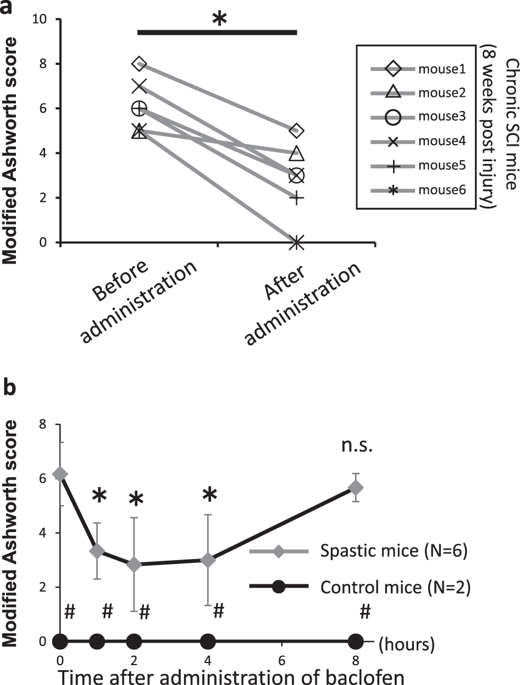当前位置:
X-MOL 学术
›
Spinal Cord
›
论文详情
Our official English website, www.x-mol.net, welcomes your
feedback! (Note: you will need to create a separate account there.)
The beneficial aspects of spasticity in relation to ambulatory ability in mice with spinal cord injury.
Spinal Cord ( IF 2.1 ) Pub Date : 2019-12-10 , DOI: 10.1038/s41393-019-0395-9 Shingo Yoshizaki 1, 2 , Kazuya Yokota 1 , Kensuke Kubota 3 , Takeyuki Saito 1 , Masatake Tanaka 2 , Dai-Jiro Konno 2 , Takeshi Maeda 3 , Yoshihiro Matsumoto 1 , Yasuharu Nakashima 1 , Seiji Okada 2
Spinal Cord ( IF 2.1 ) Pub Date : 2019-12-10 , DOI: 10.1038/s41393-019-0395-9 Shingo Yoshizaki 1, 2 , Kazuya Yokota 1 , Kensuke Kubota 3 , Takeyuki Saito 1 , Masatake Tanaka 2 , Dai-Jiro Konno 2 , Takeshi Maeda 3 , Yoshihiro Matsumoto 1 , Yasuharu Nakashima 1 , Seiji Okada 2
Affiliation

|
STUDY DESIGN
Experimental study with mice.
OBJECTIVES
Spasticity is a common complication after spinal cord injury (SCI) and has detrimental aspects, such as persistent pain and involuntary muscle spasms. This study aimed to assess the influence of antispastic therapy on locomotor function after SCI.
SETTING
University-based laboratory in Fukuoka, Japan.
METHODS
A mouse model of spasticity was developed by producing incomplete SCI at the 9th thoracic level. At 8 weeks after SCI, an antispastic drug, baclofen, was intraperitoneally administered to six injured and two sham-operated mice. The severity of spasticity was evaluated by the modified Ashworth scoring (MAS) system, and locomotor function was evaluated by the Basso-Beattie-Bresnahan (BBB) scale/Basso mouse score (BMS).
RESULTS
The administration of baclofen significantly improved spasticity in the SCI mice and the mean MAS decreased to from 6.2 to 2.8. However, at the same time, it significantly exacerbated the locomotor dysfunction of the SCI mice and the mean BMS decreased from 4.7 to 2.3. The time-course of the changes in locomotor function coincided with the time-course of the spasticity score. We also confirmed that the administration of baclofen was not associated with any changes in either locomotor function or spasticity of the sham-operated control mice.
CONCLUSIONS
Our results suggest that spasticity has a certain beneficial effect on ambulation ability. It is important to note that antispastic treatments may be associated with a risk of impairing the preserved function of chronic SCI patients.
中文翻译:

痉挛的有益方面与脊髓损伤小鼠的走动能力有关。
研究设计小鼠实验研究。目的痉挛是脊髓损伤(SCI)后的常见并发症,并具有有害的方面,例如持续性疼痛和不自主的肌肉痉挛。这项研究旨在评估抗痉挛疗法对脊髓损伤后运动功能的影响。地点位于日本福冈的大学实验室。方法通过在第9胸水平产生不完整的SCI来开发小鼠痉挛模型。在脊髓损伤后第8周,对六只受伤和两只假手术小鼠进行腹膜内施用抗痉挛药物巴氯芬。痉挛的严重程度通过改良的Ashworth评分(MAS)系统进行评估,运动功能通过Basso-Beattie-Bresnahan(BBB)量表/ Basso小鼠评分(BMS)进行评估。结果施用巴氯芬可显着改善SCI小鼠的痉挛状态,平均MAS从6.2降至2.8。但是,与此同时,它显着加重了SCI小鼠的运动功能障碍,平均BMS从4.7降至2.3。运动功能变化的时间过程与痉挛评分的时间过程一致。我们还证实,假手术对照组小鼠的运动功能或痉挛性改变与巴氯芬的施用无关。结论我们的结果表明,痉挛对运动能力具有一定的有益作用。重要的是要注意,抗痉挛治疗可能与损害慢性SCI患者的功能恢复有关。2至2.8。但是,与此同时,它显着加重了SCI小鼠的运动功能障碍,平均BMS从4.7降至2.3。运动功能变化的时间过程与痉挛评分的时间过程一致。我们还证实,假手术对照组小鼠的运动功能或痉挛性改变与巴氯芬的施用无关。结论我们的结果表明,痉挛对运动能力具有一定的有益作用。重要的是要注意,抗痉挛治疗可能与损害慢性SCI患者的功能恢复有关。2至2.8。但是,与此同时,它显着加重了SCI小鼠的运动功能障碍,平均BMS从4.7降至2.3。运动功能变化的时间过程与痉挛评分的时间过程一致。我们还证实,假手术对照组小鼠的运动功能或痉挛性改变与巴氯芬的施用无关。结论我们的结果表明,痉挛对运动能力具有一定的有益作用。重要的是要注意,抗痉挛治疗可能与损害慢性SCI患者的功能恢复有关。运动功能变化的时间过程与痉挛评分的时间过程一致。我们还证实,假手术对照组小鼠的运动功能或痉挛性改变与巴氯芬的施用无关。结论我们的结果表明,痉挛对走动能力具有一定的有益作用。重要的是要注意,抗痉挛治疗可能与损害慢性SCI患者的功能恢复有关。运动功能变化的时间过程与痉挛评分的时间过程一致。我们还证实,假手术对照组小鼠的运动功能或痉挛性改变与巴氯芬的施用无关。结论我们的结果表明,痉挛对运动能力具有一定的有益作用。重要的是要注意,抗痉挛治疗可能与损害慢性SCI患者的功能恢复有关。结论我们的结果表明,痉挛对走动能力具有一定的有益作用。重要的是要注意,抗痉挛治疗可能与损害慢性SCI患者的功能恢复有关。结论我们的结果表明,痉挛对运动能力具有一定的有益作用。重要的是要注意,抗痉挛治疗可能与损害慢性SCI患者的功能恢复有关。
更新日期:2019-12-11
中文翻译:

痉挛的有益方面与脊髓损伤小鼠的走动能力有关。
研究设计小鼠实验研究。目的痉挛是脊髓损伤(SCI)后的常见并发症,并具有有害的方面,例如持续性疼痛和不自主的肌肉痉挛。这项研究旨在评估抗痉挛疗法对脊髓损伤后运动功能的影响。地点位于日本福冈的大学实验室。方法通过在第9胸水平产生不完整的SCI来开发小鼠痉挛模型。在脊髓损伤后第8周,对六只受伤和两只假手术小鼠进行腹膜内施用抗痉挛药物巴氯芬。痉挛的严重程度通过改良的Ashworth评分(MAS)系统进行评估,运动功能通过Basso-Beattie-Bresnahan(BBB)量表/ Basso小鼠评分(BMS)进行评估。结果施用巴氯芬可显着改善SCI小鼠的痉挛状态,平均MAS从6.2降至2.8。但是,与此同时,它显着加重了SCI小鼠的运动功能障碍,平均BMS从4.7降至2.3。运动功能变化的时间过程与痉挛评分的时间过程一致。我们还证实,假手术对照组小鼠的运动功能或痉挛性改变与巴氯芬的施用无关。结论我们的结果表明,痉挛对运动能力具有一定的有益作用。重要的是要注意,抗痉挛治疗可能与损害慢性SCI患者的功能恢复有关。2至2.8。但是,与此同时,它显着加重了SCI小鼠的运动功能障碍,平均BMS从4.7降至2.3。运动功能变化的时间过程与痉挛评分的时间过程一致。我们还证实,假手术对照组小鼠的运动功能或痉挛性改变与巴氯芬的施用无关。结论我们的结果表明,痉挛对运动能力具有一定的有益作用。重要的是要注意,抗痉挛治疗可能与损害慢性SCI患者的功能恢复有关。2至2.8。但是,与此同时,它显着加重了SCI小鼠的运动功能障碍,平均BMS从4.7降至2.3。运动功能变化的时间过程与痉挛评分的时间过程一致。我们还证实,假手术对照组小鼠的运动功能或痉挛性改变与巴氯芬的施用无关。结论我们的结果表明,痉挛对运动能力具有一定的有益作用。重要的是要注意,抗痉挛治疗可能与损害慢性SCI患者的功能恢复有关。运动功能变化的时间过程与痉挛评分的时间过程一致。我们还证实,假手术对照组小鼠的运动功能或痉挛性改变与巴氯芬的施用无关。结论我们的结果表明,痉挛对走动能力具有一定的有益作用。重要的是要注意,抗痉挛治疗可能与损害慢性SCI患者的功能恢复有关。运动功能变化的时间过程与痉挛评分的时间过程一致。我们还证实,假手术对照组小鼠的运动功能或痉挛性改变与巴氯芬的施用无关。结论我们的结果表明,痉挛对运动能力具有一定的有益作用。重要的是要注意,抗痉挛治疗可能与损害慢性SCI患者的功能恢复有关。结论我们的结果表明,痉挛对走动能力具有一定的有益作用。重要的是要注意,抗痉挛治疗可能与损害慢性SCI患者的功能恢复有关。结论我们的结果表明,痉挛对运动能力具有一定的有益作用。重要的是要注意,抗痉挛治疗可能与损害慢性SCI患者的功能恢复有关。











































 京公网安备 11010802027423号
京公网安备 11010802027423号